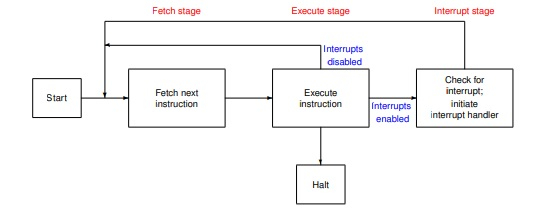
 Data Structure
Data Structure Networking
Networking RDBMS
RDBMS Operating System
Operating System Java
Java MS Excel
MS Excel iOS
iOS HTML
HTML CSS
CSS Android
Android Python
Python C Programming
C Programming C++
C++ C#
C# MongoDB
MongoDB MySQL
MySQL Javascript
Javascript PHP
PHP
- Selected Reading
- UPSC IAS Exams Notes
- Developer's Best Practices
- Questions and Answers
- Effective Resume Writing
- HR Interview Questions
- Computer Glossary
- Who is Who
What are the interrupt stages and processing?
Instruction cycle consists of fetch, execute and interrupt stage show in below diagram −

If any interrupt occurs, it is indicated by an interrupt flag. The CPU will go to interrupt handler routine. Interrupt handler then checks the type of interrupt and executes the appropriate function. It involves overhead but still better than the CPU waiting for I/O completion or other activities.
Interrupt handler activates most prior able activity first and later deferrable part will be handled.
Example
Block of data arrives on the network line.
Kernel marks the presence of data (urgent part) and gives the CPU back to the process that was running before.
Rest of processing can be done later (moving data to buffer where recipient will find it)
Interrupt vector
Table of pointers in memory contains the addresses of interrupt service routines at a fixed location for a given CPU.
Interrupt processing
Step 1 − First device issues interrupt to CPU.
Step 2 − Then, the CPU finishes execution of current instruction.
Step 3 − CPU tests for pending interrupt request. If there is one, it sends an acknowledgment to the device which removes its interrupt signal.
Step 4 − CPU saves program status word onto control stack.
Step 5 − CPU loads the location of the interrupt handler into the PC register.
Step 6 − Save the contents of all registers from the control stack into memory.
Step 7 − Find out the cause of interrupt, or interrupt type or invokes appropriate routine.
Step 8 − Restore saved registers from the stack.
Step 9 − Restore PC to dispatch the original process.

